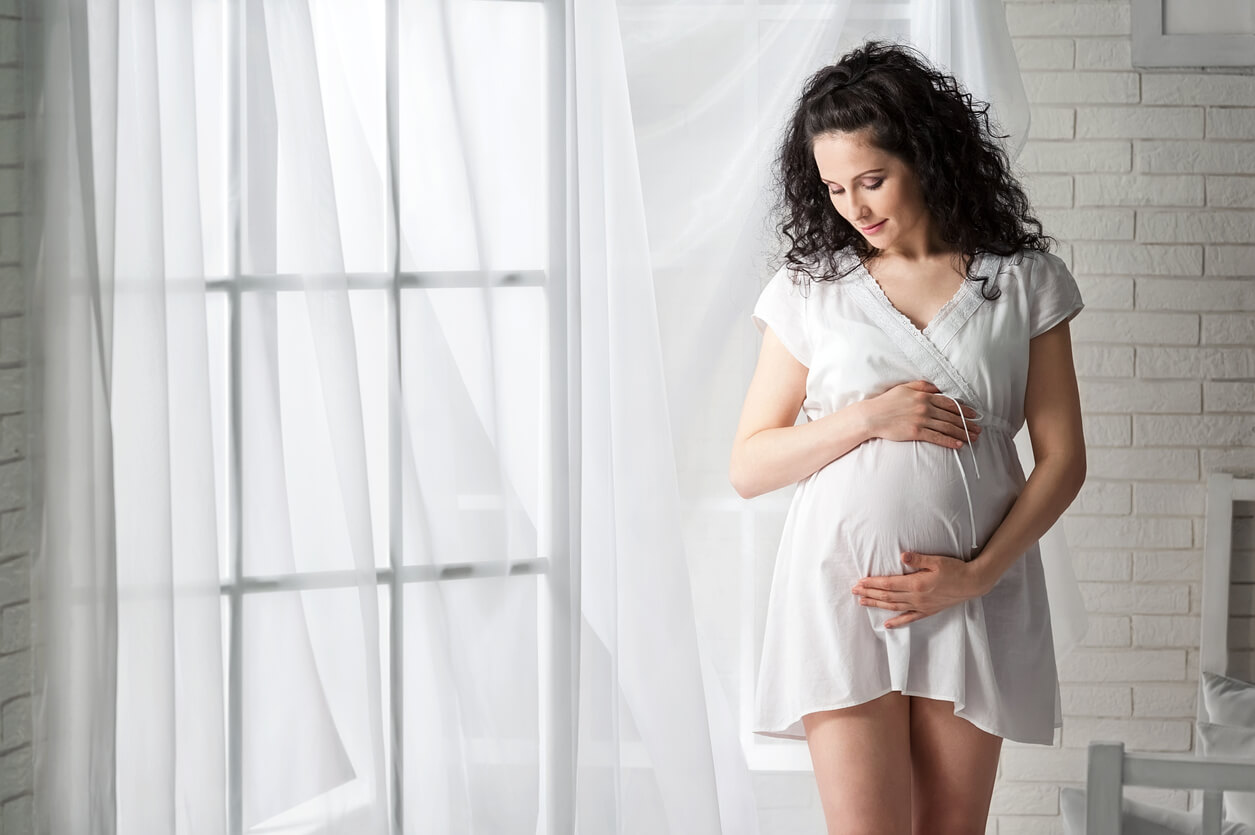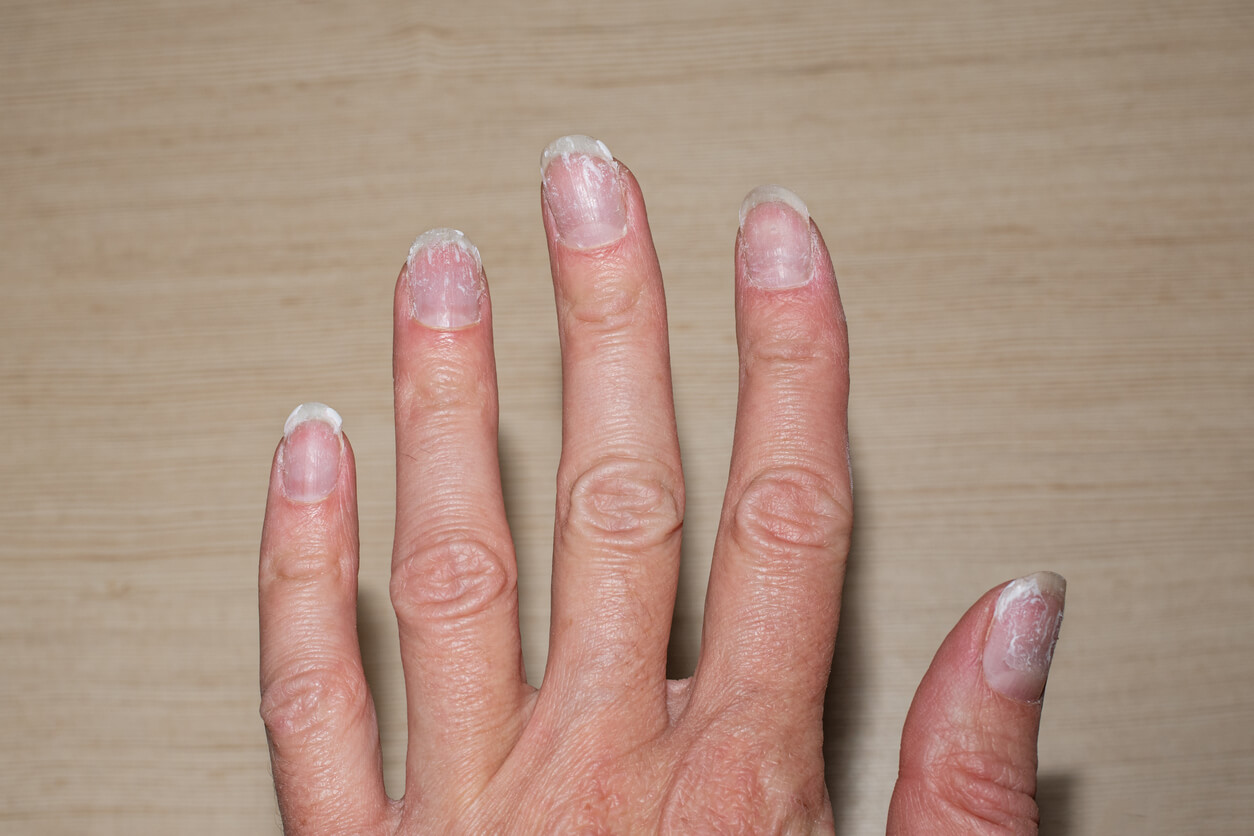Hair and Nail Changes During Pregnancy


Written and verified by the dermatologist Maria del Carmen Hernandez
While the body undergoes a variety of physiological alterations during pregnancy, hair and nail changes may be more noticeable. It’s estimated that more than 90% of women experience changes, as well as skin changes, during pregnancy.
Learn what hair and nail changes occur during pregnancy
There are many clinical manifestations that often appear during pregnancy. All of them are benign alterations that will resolve on their own in the postpartum period. Consequently, it’s important to apply moisturizing cream daily, use sunscreen on exposed areas, and maintain a complete and varied diet.
Hair loss
During pregnancy, high estrogen levels prolong the hair growth phase, resulting in less hair loss. Consequently, in the postpartum period, the hair growth and rest cycle returns to its previous pattern, so hair loss is likely to be evident.
It’s common for hair loss or telogen effluvium to occur up to a year after the birth of the baby because hormone levels and hair follicles are regulated without the influence of pregnancy hormones.
Increased hair growth
Many pregnant women experience thickening and hair growth and even more hair may be observed in unwanted places. That is, there may be more hair on the face, legs, arms, and back. The vast majority of all changes return to normal after delivery.
You may be interested in: How to Take Care of Your Hair During Pregnancy?

Nail spots
Leukonychia refers to white spots on the nails that are harmless in nature. In most cases, it’s the result of an injury to the nail from biting, direct trauma, or an allergic reaction to a product. Studies published by the International Journal of Dermatology conclude that it’s one of the most frequent changes to be observed (24%).
Leukonychia resolves on its own and disappears when the nail is fully grown, after six to eight months.
A blackish color in the nails
Another of the changes that can be evidenced during pregnancy is the presence of melanonychia, a hyperpigmented longitudinal band in the nail plate. This usually affects only one nail and is caused by the localized presence of melanin, the body’s own pigment. In addition to pregnancy, other causes include the following:
- Addison’s disease
- Trauma
- Vitamin B deficiency
- Medications
- Malnutrition
Ingrown toenails
It’s common to see ingrown toenails on the feet. In fact, this is due to wearing shoes that are too tight. Therefore, excess pressure on the feet due to fluid retention should be avoided. You should wear comfortable and wide shoes and elevate the legs during the course of the day. Whenever there are signs of infection or inflammation in the nail area, a medical specialist should be consulted.
Read also: How to Treat Ingrown Toenails
Increased nail growth
Hormonal changes during pregnancy can lead to increased nail growth and strengthening. Increased blood pressure and blood flow to the extremities are also factors that stimulate them. It’s important to wear gloves when cleaning the home and avoid direct contact with chemical products. In addition, applying moisturizer helps to maintain strong, healthy nails.

Brittle nails
While nails may grow longer during pregnancy, they also tend to tear, break, and split more easily. Weak nails can also be caused by a diet deficient in the vitamin B complex. Consequently, biotin improves the thickness, firmness, and hardness of the nails. It’s found in dairy products, vegetables, eggs, and fish.
Subungual keratosis
Subungual keratosis usually occurs in 7% of pregnant women. It’s characterized by abnormal growth below the nail plate. In this case, there’s a thickening of the nail bed, which keratinizes and accumulates in the subungual space.
Hair and nail changes during pregnancy
The vast majority of hair and nail changes that occur during pregnancy resolve spontaneously after the baby is born. Ideally, pregnant women should be aware of the physiological and temporary nature of all these alterations in the body. This will alleviate any type of anxiety or worry.
While the body undergoes a variety of physiological alterations during pregnancy, hair and nail changes may be more noticeable. It’s estimated that more than 90% of women experience changes, as well as skin changes, during pregnancy.
Learn what hair and nail changes occur during pregnancy
There are many clinical manifestations that often appear during pregnancy. All of them are benign alterations that will resolve on their own in the postpartum period. Consequently, it’s important to apply moisturizing cream daily, use sunscreen on exposed areas, and maintain a complete and varied diet.
Hair loss
During pregnancy, high estrogen levels prolong the hair growth phase, resulting in less hair loss. Consequently, in the postpartum period, the hair growth and rest cycle returns to its previous pattern, so hair loss is likely to be evident.
It’s common for hair loss or telogen effluvium to occur up to a year after the birth of the baby because hormone levels and hair follicles are regulated without the influence of pregnancy hormones.
Increased hair growth
Many pregnant women experience thickening and hair growth and even more hair may be observed in unwanted places. That is, there may be more hair on the face, legs, arms, and back. The vast majority of all changes return to normal after delivery.
You may be interested in: How to Take Care of Your Hair During Pregnancy?

Nail spots
Leukonychia refers to white spots on the nails that are harmless in nature. In most cases, it’s the result of an injury to the nail from biting, direct trauma, or an allergic reaction to a product. Studies published by the International Journal of Dermatology conclude that it’s one of the most frequent changes to be observed (24%).
Leukonychia resolves on its own and disappears when the nail is fully grown, after six to eight months.
A blackish color in the nails
Another of the changes that can be evidenced during pregnancy is the presence of melanonychia, a hyperpigmented longitudinal band in the nail plate. This usually affects only one nail and is caused by the localized presence of melanin, the body’s own pigment. In addition to pregnancy, other causes include the following:
- Addison’s disease
- Trauma
- Vitamin B deficiency
- Medications
- Malnutrition
Ingrown toenails
It’s common to see ingrown toenails on the feet. In fact, this is due to wearing shoes that are too tight. Therefore, excess pressure on the feet due to fluid retention should be avoided. You should wear comfortable and wide shoes and elevate the legs during the course of the day. Whenever there are signs of infection or inflammation in the nail area, a medical specialist should be consulted.
Read also: How to Treat Ingrown Toenails
Increased nail growth
Hormonal changes during pregnancy can lead to increased nail growth and strengthening. Increased blood pressure and blood flow to the extremities are also factors that stimulate them. It’s important to wear gloves when cleaning the home and avoid direct contact with chemical products. In addition, applying moisturizer helps to maintain strong, healthy nails.

Brittle nails
While nails may grow longer during pregnancy, they also tend to tear, break, and split more easily. Weak nails can also be caused by a diet deficient in the vitamin B complex. Consequently, biotin improves the thickness, firmness, and hardness of the nails. It’s found in dairy products, vegetables, eggs, and fish.
Subungual keratosis
Subungual keratosis usually occurs in 7% of pregnant women. It’s characterized by abnormal growth below the nail plate. In this case, there’s a thickening of the nail bed, which keratinizes and accumulates in the subungual space.
Hair and nail changes during pregnancy
The vast majority of hair and nail changes that occur during pregnancy resolve spontaneously after the baby is born. Ideally, pregnant women should be aware of the physiological and temporary nature of all these alterations in the body. This will alleviate any type of anxiety or worry.
All cited sources were thoroughly reviewed by our team to ensure their quality, reliability, currency, and validity. The bibliography of this article was considered reliable and of academic or scientific accuracy.
- Erpolat S, Eser A, Kaygusuz I, Balci H, Kosus A, Kosus N. Nail alterations during pregnancy: a clinical study. Int J Dermatol. 2016 Oct;55(10):1172-5. doi: 10.1111/ijd.13316. Epub 2016 Apr 20. PMID: 27097299.
- Vora RV, Gupta R, Mehta MJ, Chaudhari AH, Pilani AP, Patel N. Pregnancy and skin. J Family Med Prim Care. 2014;3(4):318-324. doi:10.4103/2249-4863.148099
- Gizlenti S, Ekmekci TR. The changes in the hair cycle during gestation and the post-partum period. J Eur Acad Dermatol Venereol. 2014 Jul;28(7):878-81. doi: 10.1111/jdv.12188. Epub 2013 May 20. PMID: 23682615.
- Bistas KG, Tadi P. Biotin. 2021 Feb 12. In: StatPearls [Internet]. Treasure Island (FL): StatPearls Publishing; 2021 Jan–. PMID: 32119380.
- Malkud S. Telogen Effluvium: una revisión. J Clin Diagn Res. 2015; 9 (9): WE01-WE3. doi: 10.7860 / JCDR / 2015 / 15219.6492
This text is provided for informational purposes only and does not replace consultation with a professional. If in doubt, consult your specialist.








